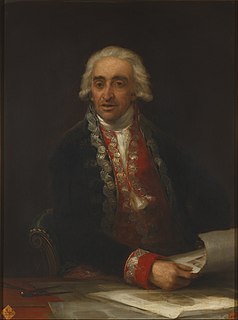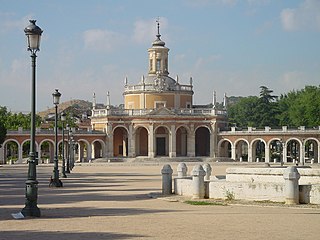
Aranjuez is a city and municipality of Spain, part of the Community of Madrid.

El Escorial, or the Royal Site of San Lorenzo de El Escorial, or Monasterio del Escorial, is a historical residence of the King of Spain located in the town of San Lorenzo de El Escorial, 2.06 km (1.28 mi) up the valley from the town of El Escorial and about 45 kilometres northwest of the Spanish capital Madrid. Built between 1563 and 1584 by order of King Philip II, El Escorial is the largest Renaissance building in the world. It is one of the Spanish royal sites and functions as a monastery, basilica, royal palace, pantheon, library, museum, university, school, and hospital.

San Lorenzo de El Escorial, also known as El Escorial de Arriba, is a town and municipality in the Community of Madrid, Spain, located to the northwest of the region in the southeastern side of the Sierra de Guadarrama, at the foot of Mount Abantos and Las Machotas, 47 kilometres (29 mi) from Madrid. It is head of the eponymous judicial party. The settlement is popularly called El Escorial de Arriba, to differentiate it from the neighbouring village of El Escorial, also known as El Escorial de Abajo.

The Buen Retiro Park, Retiro Park or simply El Retiro is one of the largest parks of the city of Madrid, Spain. The park belonged to the Spanish Monarchy until the late 19th century, when it became a public park.

The Royal Palace of Madrid is the official residence of the Spanish royal family at the city of Madrid, although now used only for state ceremonies. The palace has 135,000 m2 (1,450,000 sq ft) of floor space and contains 3,418 rooms. It is the largest functioning royal palace and the largest by floor area in Europe.

The Royal Palace of Aranjuez is a former Spanish royal residence. It is located 50 km south of Madrid in the town of Aranjuez, Spain.

The Paseo del Prado is one of the main boulevards in Madrid, Spain. It runs north–south between the Plaza de Cibeles and the Plaza del Emperador Carlos V, with the Plaza de Cánovas del Castillo lying approximately in the middle. The Paseo del Prado forms the southern end of the city's central axis. It enjoys the status of Bien de Interés Cultural (BIC), and as part of a combined UNESCO World Heritage Site with Buen Retiro Park.

The Royal Alcázars of Seville, historically known as al-Qasr al-Muriq and commonly known as the Alcázar of Seville, is a royal palace in Seville, Spain, built for the Christian king Peter of Castile. It was built by Castilian Christians on the site of an Abbadid Muslim alcazar, or residential fortress. The fortress was destroyed after the Christian conquest of Seville in 1248.

Juan de Villanueva was a Spanish architect. Alongside Ventura Rodríguez, Villanueva is the best known architect of Spanish Neoclassicism.

Patrimonio Nacional is a Spanish autonomous agency, under the jurisdiction of the Ministry of the Presidency, that administers the sites owned by the Spanish State and used by the Monarch and the Spanish Royal Family as residences and for State Ceremonies. The Patrimonio Nacional includes palaces, gardens, monasteries and convents, called the Royal sites. When not in official use, the Royal sites are open to the public. It also manages the residences of the president of the government of Spain.

Mariana Victoria of Portugal was a Portuguese Infanta (princess), the eldest daughter of Queen Maria I of Portugal and her king-consort, Infante Pedro of Portugal.

Buen Retiro Palace in Madrid was a large palace complex designed by the architect Alonso Carbonell and built on the orders of Philip IV of Spain as a secondary residence and place of recreation. It was built in what was then the eastern limits of the city of Madrid. Today, what little remains of its buildings and gardens forms the Retiro Park.

The Casita del Infante is a historic building in San Lorenzo de El Escorial, Spain. It was constructed as a private home for the Infante Gabriel of Spain, hence its name. The small residence was built in the late 18th century during the reign of his father, Charles III of Spain.

The Church of San Antonio is a church located in Aranjuez, in the Community of Madrid, Spain. It was declared Bien de Interés Cultural and a World Heritage Site by UNESCO within Aranjuez Cultural Landscape in 2003.

The Casita del Príncipe is an eighteenth-century building located in San Lorenzo de El Escorial, Spain. It was designed by the neoclassical architect Juan de Villanueva for the private use of the heir to the Spanish throne Charles, Prince of Asturias, and his wife Maria Luisa. It was constructed in the 1770s and extended in the 1780s.

Real Fábrica del Buen Retiro was a porcelain manufacturing factory in Spain. It was located in Madrid's Parque del Buen Retiro, Madrid on a site near the Fuente del Ángel Caído.

The Casita del Príncipe is an eighteenth-century house near the Royal Palace of El Pardo which is set in a hunting estate north of Madrid. The building was designed by the neoclassical architect Juan de Villanueva for the use of the heir to the Spanish throne Charles, Prince of Asturias. Construction began in 1784.

The Palacio de La Moncloa before the Spanish Civil War was the old palace before it suffered damage during the Spanish Civil War, and after be rebuilt to the current Palacio de La Moncloa with a very different layout from the original.

Juan Gálvez was a Spanish artist who served as court painter for King Ferdinand VII and Director of the Real Academia de Bellas Artes de San Fernando.





















